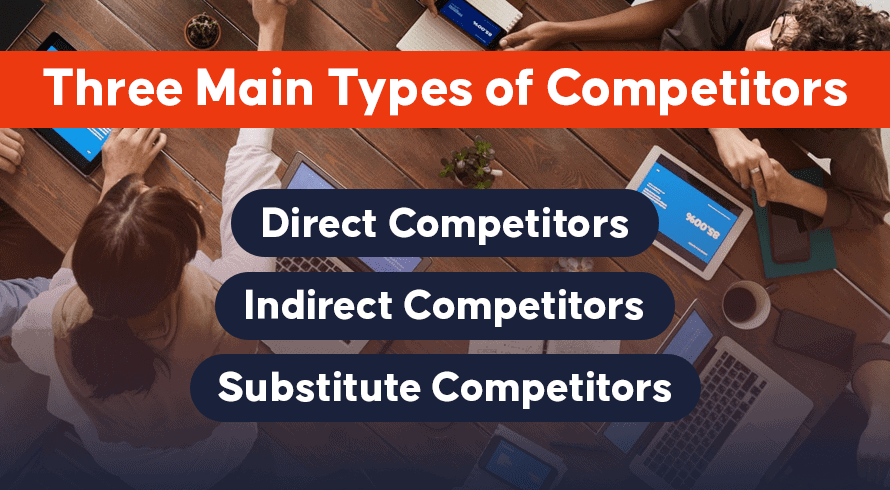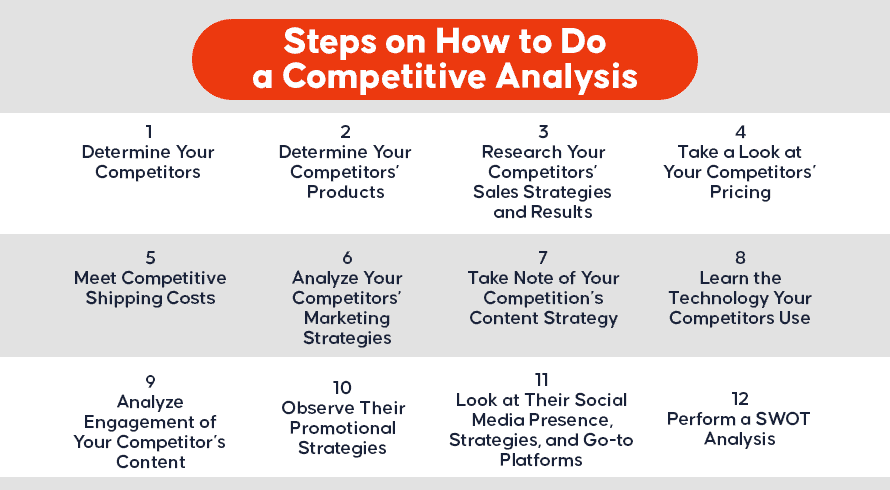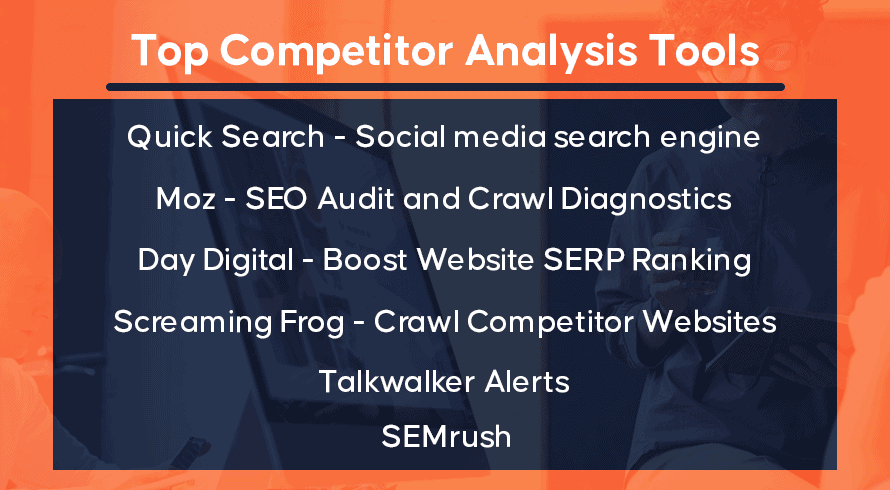Inquivix HQ
1-903, 18 Eonju-ro 146-gil,
Gangnam-gu, Seoul, Korea
06057

Competitors analysis is one of the first things you should do once you have your target audience and product or service defined. This is where you find out what other companies are doing for the same demographic segment, what they offer, the cost of their products, etc. The goal here is to see whether there is room for another player (or several players) in the market, or if it’s too late.
Once you have this information, you can start to craft your marketing strategy around what your competition is doing. If they are targeting a different audience, for example, you can focus on reaching the same market as them. If their prices are significantly higher than yours, you can try to gain some of their market shares. This analysis should be done periodically, as the market can change quickly and your competitors may adapt their strategy in response to what you’re doing. Always be prepared to adjust your own plans accordingly.
What Is Competitors Analysis?
Competitor analysis is the process of studying the marketing strategies, products, or services, and campaigns of your competitors. You have to select the right competitors for your niche. It is important to identify which aspects you need to analyze and where to find the relevant data. After collecting data, you need to study them in-depth to evaluate their performance and what you can learn from them in order to strategize for your business. This will give your business a competitive advantage.
The Importance of Conducting a Competitive Analysis
Conducting a competitive analysis has very much importance to any business. To start with, an in-depth understanding of the competitors is very important in ensuring that your expectations are realistic and you can come up with a plan to compete successfully or carve out a niche for yourself to give you a competitive edge over them. In other cases, it can help you to determine whether there is a market need for your product/service.
Competitive analysis is important for several reasons.
- It can help you set realistic expectations for your business. If you understand what your competitors are doing, you won’t expect to achieve the same level of success overnight.
- It can help you determine whether there is a market for your product/service. If you can identify a need that your competitors are not meeting, you may have an opportunity to fill that gap.
- It can help you improve your products/services. By understanding what your customers want from their current suppliers, you can work to provide them with what they need and exceed their expectations.
- It can help you stay ahead of the competition. Keeping tabs on your competitors is essential for any business that wants to succeed.
- It can help you make better business decisions. Having a good understanding of the competitive landscape allows you to make informed decisions about pricing, product development, and marketing strategies.

- It increases productivity. Conducting a thorough competitive analysis will help you to focus your efforts on the areas that are most important, saving you time and money in the long run.
- It builds a foundation of trust with customers and partners. When you can demonstrate that you understand your industry and what makes your company unique, you create a foundation of trust that can be built upon over time.
Conducting a competitive analysis is an essential part of any business strategy. By understanding your competitors’ strengths and weaknesses, you can work to differentiate your business and thrive in today’s competitive market.
Understand Market Conditions
When looking to invest in a new market, it is important to understand the current conditions. This includes understanding the competition in the market and their strategies. Competition is the most important factor in deciding whether to enter a market. That’s because it defines how much money can be made. If there are no competitors, this means you have the entire market to yourself and you will make huge profits easily. On the other hand, if everyone in your niche is doing similar things, your returns will be small.
Identify Strengths and Weaknesses
You have to know the strengths and weaknesses of your business in order to plan ahead. Capitalize on your strengths and improve your weaknesses. Today’s market is highly competitive with various players targeting the same audience as you are. Knowing how to manage your strengths and weaknesses compared to your competitors will help you determine a workable strategy for your business.
Design / Adjust Go-To-Market (GTM) Strategy
A comprehensive competitive analysis framework will help you to understand your market in order to reach your target audience. Understanding how your competitors are performing can help you to identify how your business and its product/service will fit in.
Three Main Types of Competitors
Before you start a competitor analysis, you need to determine who your competitors are. Check to see if they are targeting the same audience, selling similar products/services, or other factors that affect your business. Here are three main types of competitors you need to consider.
Direct Competitors
Direct competitors are those companies that sell the same or a very similar product or service as you do. They, also, share the same target audience as yours. Direct competitors, most of the time have similar goals as your business. You also need to consider potential direct competitors. Potential competitors are those companies that have not yet entered the market, but that could do so in the future.
Indirect Competitors
Indirect competitors are companies that offer a similar product or service, but with a different end goal. They may not drive their revenue from the same product as you, but offer it in a different context.
For example, if you are a gaming company that sells video games, but there is another company that sells snacks but promotes their product with a free video game. Though they offer a similar product, they do not drive their revenue from it, but it can affect your bottom line.
This competitor is an indirect competitor because it does not sell products that directly compete with those offered by your business but affect you nonetheless.

Substitute Competitors
A substitute competitor is a company that offers a completely different product/service but targets the same audience. These companies are competitors because if their offer can prove to be more attractive than yours, they may be able to attract customers who would otherwise buy from you.
For example, a toy shop and a children’s bookstore are substitute competitors for each other. Their products are completely different, yet they target the same market.
Steps on How to Do a Competitive Analysis
If you are wondering how to do a competitive analysis, here are the steps you need to follow
#1 Determine Your Competitors
The first step is to determine your competitors. Divide them into two main categories; direct and indirect competitors. You can add a third category as substitute competitors. We discussed them in the section above.
#2 Determine Your Competitors’ Products
Learn what your competitors are offering. Identify their entire line of products, their pricing, and their quality. This will help you to learn how competitive the product range is and the opportunities you can take advantage of.

#3 Research Your Competitors’ Sales Strategies and Results
You need to know how the competitors are driving their sales. What are the strategies they are using to increase sales? You need to know how competitive the sales process is going to be.
#4 Take a Look at Your Competitors’ Pricing
When it comes to pricing your own products, one key factor that affects it is competitor pricing. Analyzing your competitors’ pricing will guide you on how best to price your product. Will you be able to offer a superior product for the same price or a little higher?
#5 Meet Competitive Shipping Costs
Shipping costs affect your sales, especially if you are an online retailer. If your competitors are offering free shipping, you might want to figure out a solution for your business.
Top Competitor Analysis Tools
Conducting a competitor analysis can be challenging. Using a competitor analysis tool will benefit your business immensely. The following are the top competitor analysis tools that will help you understand your competition and how to strategically market your business.
Quick Search
This is a social media search engine that helps you find the social web’s most relevant conversations about topics that are important to your business. This offers comprehensive coverage of social media networks, news sites, forums, and blogs.
Moz – SEO Audit and Crawl Diagnostics
Moz is a search engine optimization (SEO) tool that offers both a free and paid subscription. Moz provides in-depth SEO audits of your website, as well as detailed information about your competitors’ SEO strategies.
Day Digital
Day Digital is a digital marketing agency that offers a suite of tools to help businesses boost their website’s search engine ranking (SERP). Their tools include an SEO analyzer, as well as a backlink checker and domain authority tool.

Screaming Frog
Screaming Frog is a website crawler that allows you to quickly and easily scan the content of your competitor’s websites. This tool can help you identify which of your competitor’s pages are ranking highest in search engine results pages (SERPs), as well as identify any potential SEO issues with those pages.
Talkwalker Alerts
Talkwalker Alerts is a social media monitoring tool that allows you to track your competitor’s online presence. This tool gives you the ability to receive real-time alerts whenever your competitor publishes new content or makes any changes to their social media profiles.
SEMrush
SEMrush is an online competitive intelligence tool that offers a suite of features designed to help you find new keywords, ad copy, and marketing ideas. SEMrush also provides traffic estimation for organic search, paid search (PPC), and display networks.
Conclusion
For every business to thrive in the highly competitive market, they need to conduct competitor analysis. Identifying your competitors’ strengths and weaknesses will give you a competitive advantage. Competitive research will provide you with information on market share, marketing tactics, potential customers, competitors’ customer service, industry trends, and more. This article discussed the importance of competitor analysis as well as steps to conduct a comprehensive competitive analysis.
